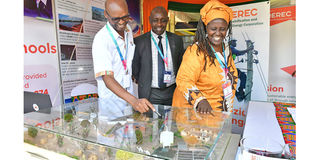Focus on rural electrification and renewable energy as a response to the challenges of climate change in Kenya
Sponsored by Rural Electrification and Renewable Energy Corporation

REREC Board Chair, Wachuka Ikua (right), with the CEO, CPA Peter Mbugua (centre), and a senior officer, at the Corporation’s stand during the KUSI Ideas Festival 2022 that took place at Karura Forest on December 8-9, focusing on climate change.
Over the past 10 years, Kenya’s Rural Electrification and Renewable Energy Corporation (REREC) has undergone a phenomenal transition in its operations and service delivery to communities.
The Corporation was established under the provisions of the Energy Act of 2019 to succeed the Rural Electrification Authority (REA). It is aligned with the Kenya Vision 2030 (the national economic development blueprint), and the UN Sustainable Development Goals (SDGs).
In support of the Government of Kenya’s pledge to stimulate economic growth, accelerate job creation, and promote sustainable socio-economic development as well as the general economic wellbeing of Kenyans, REREC has been spearheading the development of renewable energy sources in the country as it implements rural electrification projects.
So far, the Corporation has implemented electrification projects connecting 75 percent of all public facilities, such as hospitals, schools, water boreholes, and trading centres, at an approximate costof Ksh120.3 billion. To date, the Corporation has electrified 60,934 public facilities that are connected either to the national grid or solar photovoltaic (PV) technology. Out of these public facilities, 2,927 primary schools have been connected to electricity, enabling the actualisation of the Digital Literacy Programme (DLP).
The Corporation has also constructed the 120km Turkwel-Lokichar line to open up Northern Kenya, and has installed 104 high-mast floodlights in informal settlements of Kibera, Mathare, Korogocho, Ngomongo, and Mukuru kwa Njenga in the capital city, Nairobi, as well as Kiandutu in Thika town.
REREC’s enhanced mandate of driving the green economy agenda through research, development, and promotion of the adoption of renewable energy technologies, places it at the centre-stage of contributing to the country’s agenda on clean cooking and curbing carbon emissions.
Notably, renewable energy in Kenya currently accounts for 73 percent of the installed power generation capacity, while 90 percent of the electricity in use is from clean sources. Despite this inclination towards zero emission score, a majority of urban and peri-urban populations in Kenyan continue to rely on the harmful wood fuels and kerosene for cooking.
One of the mitigation interventions the country should put in place is to enhance the promotion of investments that work towards attaining the goal of using renewable alternatives such as solar, geothermal, tidal waves, mini hydros, cogeneration green hydrogen, and even municipal waste. REREC’s major contributions towards combating climate change revolve around emission reduction and adaptation strategies.
The Garissa Solar power plant implemented by REREC has an installed capacity of 54.4MWp, and produces approximately 77gwh per year of electricity, enough to supply clean energy to power approximately 70,000 households.
The plant has supplied a total of 354,259MWh to the Kenyan national grid at an average daily generation of 235MWh. This translates to an estimate of Ksh2.09 billion in revenues. This plant reduces the carbon footprint by approximately 43,000 tons of carbon-dioxide (CO2) emissions per year.
Through the Kenya Off-Grid Solar Access Project (KOSAP), Kenya Power and Lighting Company (KPLC), together with REREC, are partnering with the World Bank (WB) in developing 120 mini-grids (48 under REREC and 72 under KPLC), with the aim of increasing access to electricity in the 14 underserved counties in Kenya. In addition, under the KOSAP framework, the World Bank, in partnership with the energy sector agencies, is committed to installing 1,100 stand-alone solar systems on public facilities, targeting 14 counties in the Northern and North-Eastern regions. Each of these projects will have a great impact on CO2 emissions by contributing to a minimum reduction of 4,800g of CO2 hourly.
Energy centres are gaining traction in the promotion of renewable and sustainable energy technologies. Currently, REREC is running 16 energy centres across the country.
In the 2021-2022 financial year, REREC energy centres produced and distributed 890,200 fast maturing tree seedlings. Promoting agroforestry through distribution and planting of fast maturing tree seedlings in learning institutions is in tandem with the National Government’s target of 10 percent forest cover, which raises the carbon sink absorption of CO2 from the atmosphere.
The aim is to scale up the application and adoption of renewable energy in the country, while providing a clear action path for various renewable energy technologies. These include, but are not limited to, biomass, alternative sources of energy, green hydrogen, and various applications of renewable energy technologies like electrification, cooking, water heating, and water pumping, among others.
Through a robust advocacy and training framework in place, the energy centres are utilised as focal points for promoting and disseminating knowledge about these technologies.
You can read more about REREC here.


